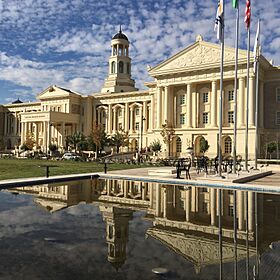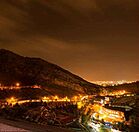Duhok facts for kids
Quick facts for kids
Duhok
Dihok
|
|
|---|---|
|
Top-bottom, R-L:
View over Dohuk American University of Kurdistan, Dohuk • Sharansh Waterfall Dohuk at night • Assyrian Mar Narsai Church |
|
| Country | |
| Region | Kurdistan Region |
| Governorate | Duhok Governorate |
| District | Duhok District |
| Elevation | 1,854 ft (565 m) |
| Population | |
| • Estimate
(2018)
|
340,871 |
| Time zone | UTC+3 (Arabian Standard Time) |
| Postcode |
42001
|
| Area code(s) | 062 |
Duhok is a city in the Kurdistan Region of Iraq. It is the main city, or capital, of the Duhok Governorate.
Contents
What's in a Name?
The name Duhok comes from two Kurdish words: 'du' (meaning two) and 'hok' (meaning lump). Long ago, people paid taxes with two 'lumps' of wheat or barley from their baskets as they passed through.
Some history says Duhok was first called Dohuk-e Dasinya, which meant "Dohuk of the Yezidis". After some difficult times for the Yezidis, the town was left empty. Later, Muslims, Christians, and Jewish people came to live there.
Who Lives in Duhok?
Duhok is home to many different groups of people. Most residents are Kurds. There are also smaller groups like Assyrians, Yazidis, and Arabs.
The city also welcomes many people who have had to leave their homes. Tens of thousands of refugees from Syria, mostly Syrian Kurds, live here. There are also many internally displaced persons (IDPs). These are people who had to move from other parts of Iraq, especially Yazidis and Assyrians who fled when ISIS took over Mosul.
As of March 2024, the Kurdistan Regional Government reported that the Kurdistan Region hosts over 631,000 IDPs. About 40% of these people live in Duhok Governorate. Also, there are over 251,000 Syrian refugees, with about 131,000 of them living in Duhok Governorate.
A Look Back in Time
Duhok has a very long history. It was part of the ancient Assyrian and Hurrian empires. It was originally an Assyrian city called Nuhadra.
Later, around the 13th or 14th centuries, Duhok became part of the Badinan principality. This was a Kurdish area ruled by the Hakkari tribe. A famous traveler named Evliya Celebi wrote that this area was divided into several parts, including Duhok.
Duhok in Ottoman Times
In 1820, a traveler named Rich described Duhok as a small town with 300 houses. It was the main place for the Doski tribe.
In 1851, a missionary named Henry Aaron Stern visited Duhok. He noticed that many different people lived there, including Jewish residents. He also said that the village mayor was an Assyrian Christian. By 1859, there were enough Jewish people for two minyans (groups for prayer). At that time, about 100 families were Muslim or Assyrian Christian.
By 1929, Duhok had about 3,500 people. Most were Kurds. Among the 550 families, 65 were Assyrian Christian, and 30 were Jewish.
Duhok in Modern Times
A big step for Duhok was the founding of the University of Duhok on October 31, 1992. This brought new learning and growth to the city.
Amazing Discoveries
Duhok is a place with many hidden historical treasures.
In 2020, researchers found an ancient stone tablet in the Balyuz hills, near Duhok City. This tablet has Greek writing on it and is about 2,100 years old! It mentions Demetrius, who was a ruler in the area long ago.
Just seven kilometers southwest of Duhok, you can find Halamata Cave. This is an archaeological site with amazing carvings on the rocks. These are known as the Maltai Reliefs. They were made by the Assyrian king Sennacherib (who ruled from 704–681 BCE). These carvings are part of an old canal system he built to bring water to his capital city, Nineveh.
Duhok's Weather
Duhok has a hot-summer Mediterranean climate (Csa). This means it has very hot, dry summers with almost no rain. The winters are cool to cold and wet.
Most of the rain falls in the cooler months, especially in late winter and early spring. Duhok might get snow two or three days a year, with more snow in the higher areas. Summers are usually rain-free, and the rain returns in late autumn.
| Climate data for Duhok, Iraq | |||||||||||||
|---|---|---|---|---|---|---|---|---|---|---|---|---|---|
| Month | Jan | Feb | Mar | Apr | May | Jun | Jul | Aug | Sep | Oct | Nov | Dec | Year |
| Record high °C (°F) | 20 (68) |
27 (81) |
30 (86) |
34 (93) |
38 (100) |
41 (106) |
45 (113) |
46 (115) |
44 (111) |
39 (102) |
31 (88) |
24 (75) |
46 (115) |
| Mean daily maximum °C (°F) | 11 (52) |
14 (57) |
19 (66) |
24 (75) |
32 (90) |
38 (100) |
42 (108) |
41 (106) |
37 (99) |
29 (84) |
20 (68) |
13 (55) |
27 (80) |
| Daily mean °C (°F) | 7 (45) |
10 (50) |
14 (57) |
18 (64) |
25 (77) |
31 (88) |
34 (93) |
34 (93) |
29 (84) |
22 (72) |
14 (57) |
9 (48) |
21 (69) |
| Mean daily minimum °C (°F) | 3 (37) |
5 (41) |
9 (48) |
13 (55) |
18 (64) |
23 (73) |
27 (81) |
26 (79) |
21 (70) |
15 (59) |
8 (46) |
6 (43) |
15 (58) |
| Record low °C (°F) | −4 (25) |
−6 (21) |
−1 (30) |
3 (37) |
6 (43) |
10 (50) |
13 (55) |
17 (63) |
11 (52) |
4 (39) |
−2 (28) |
−2 (28) |
−6 (21) |
| Average precipitation mm (inches) | 92.2 (3.63) |
99.3 (3.91) |
105 (4.1) |
96.4 (3.80) |
44.3 (1.74) |
4.9 (0.19) |
0.1 (0.00) |
0.1 (0.00) |
2.1 (0.08) |
36 (1.4) |
68.9 (2.71) |
95.8 (3.77) |
645.1 (25.33) |
| Average precipitation days | 13.1 | 11.5 | 12.2 | 12 | 7.6 | 2.5 | 3.3 | 3.6 | 3.1 | 6.1 | 8 | 10.2 | 93.2 |
| Average snowy days | 1 | 0 | 0 | 0 | 0 | 0 | 0 | 0 | 0 | 0 | 0 | 0 | 1 |
| Average relative humidity (%) | 72.4 | 69.4 | 64.5 | 60.2 | 46 | 30.5 | 25.8 | 26.7 | 30.6 | 46.8 | 62.9 | 72.9 | 50.7 |
| Average dew point °C (°F) | −0.1 (31.8) |
1.0 (33.8) |
3.8 (38.8) |
7.5 (45.5) |
9.2 (48.6) |
8.2 (46.8) |
9.2 (48.6) |
9.1 (48.4) |
7.6 (45.7) |
7.6 (45.7) |
5.2 (41.4) |
2.0 (35.6) |
5.9 (42.6) |
| Percent possible sunshine | 50.1 | 53.2 | 56.4 | 57.8 | 70.2 | 89.8 | 95.2 | 94.4 | 90.5 | 71.8 | 59.5 | 50.1 | 69.9 |
| Source 1: My Forecast | |||||||||||||
| Source 2: Weatherbase (precipitation-precip days-humidity-dew point-sun) | |||||||||||||
See Also
 In Spanish: Duhok para niños
In Spanish: Duhok para niños






